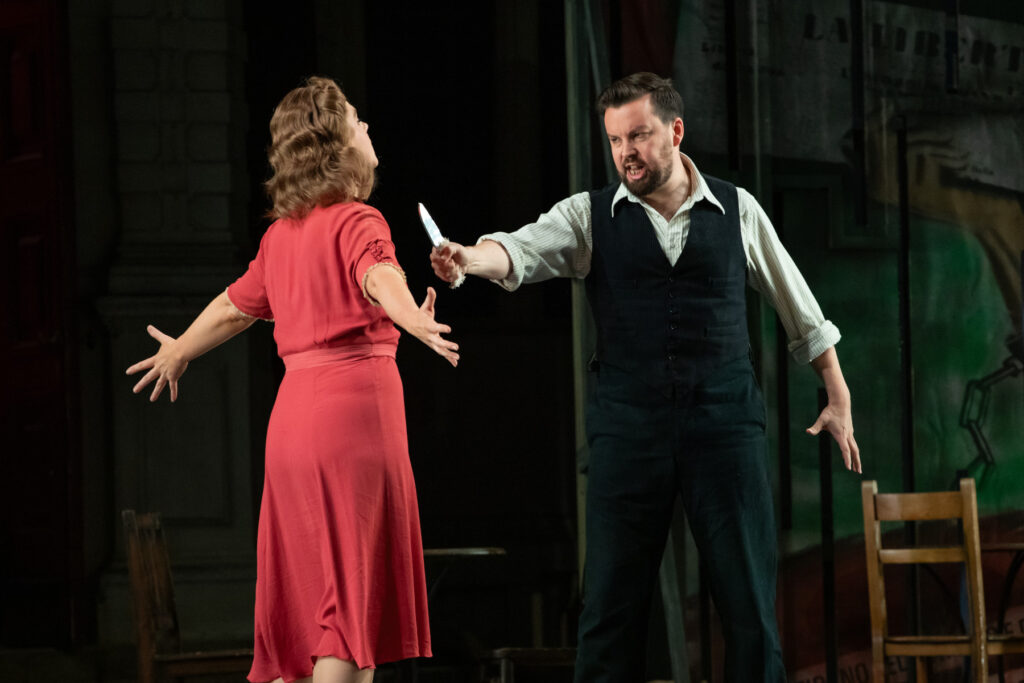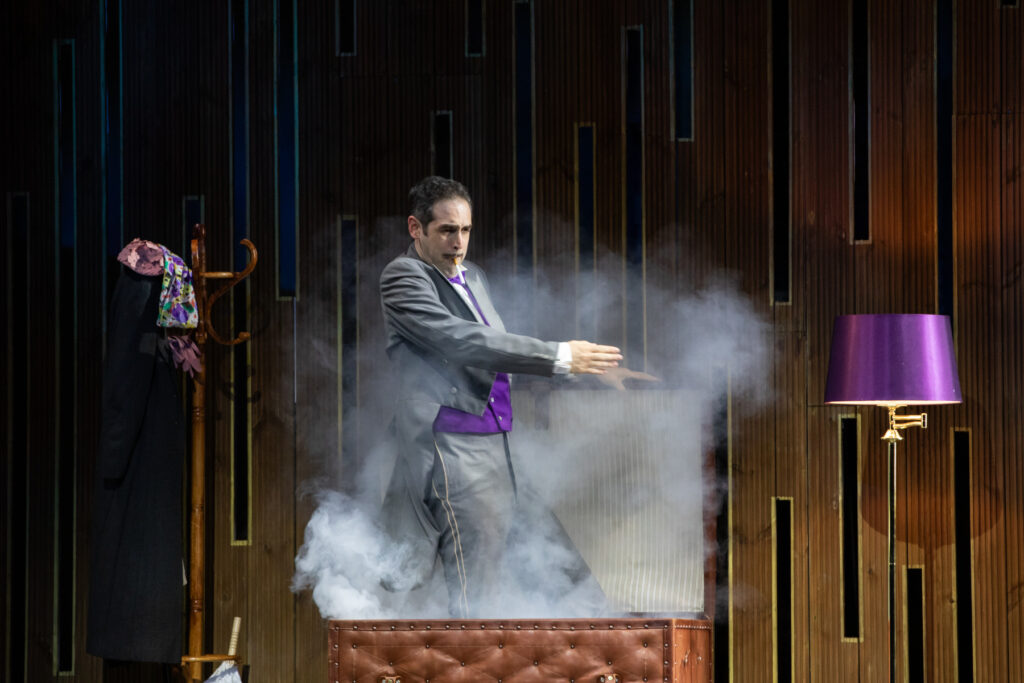‘Cav and Pag get a divorce’ is Opera Holland Park’s promotional line for its double bill, which prefaces Leoncavallo’s familiar Pagliacci with a relatively rarely seen work, Wolf-Ferrari’s Il segreto di Susanna. The two compact operas make a couple that is more apt than odd. Both deal with the themes of marital infidelity and perceptions of reality. Cuckoldry is a driving force in Cavalleria rusticana too, but Mascagni’s meaty one-acter makes a heavyweight appetiser for the similarly red-blooded (if more sophisticated) Pagliacci. Susanna, meanwhile, was conceived by its composer as an ‘intermezzo’ in the historical vein of Pergolesi’s La serva padrona, a short opera designed to dovetail with a more substantial work. As a comedy, Susanna acts as a contrasting appetiser to Pagliacci while pre-echoing the climactic commedia dell’arte play that goes so fatally wrong.
First seen in Munich in 1909, some 17 years after Pagliacci’s premiere in Milan, Il segreto di Susanna makes no claims to progressiveness, despite suggestions of the ‘New Woman’ in the recently married Countess Susanna – asserting her independence by slipping out alone when her husband is absent, and (the big secret) taking up smoking. Wolf-Ferrari’s exquisitely crafted music often seems to evolve out of late Verdi, especially Falstaff (the love music for Nannetta and Fenton as Susanna enjoys a cigarette, and, as her husband Count Gil becomes frenzied, Ford’s ‘Jealousy’ aria), and Otello (the initial Act 3 exchanges between Otello and Desdemona in the first colloquy between Susanna and Gil). For all its charm and adept touches, such as its moments of Straussian chromaticism, the score never quite carries the listener away, and its more delicate sonorities are perhaps too vaporous for the semi-open-air setting of Opera Holland Park. This is not, however, to fault the flair, precision and affection of John Andrews’ conducting or the refinement and spirit of the City of London Sinfonia’s responses.

John Wilkie’s deftly engineered production, set by Takis in a swish drawing room that combines Italian Empire and Art Deco, was first seen in 2019, when its companion piece was Tchaikovsky’s Iolanta. As Count Gil, Richard Burkhard (recently Bottom in Garsington’s Midsummer Night’s Dream) combines rich, substantial tone with pinpoint Italian diction. Clad in a dusty-pink suit, he is a subtle comic actor, simultaneously elegant and gently self-lampooning. Clare Presland makes a mercurial and alluring Susanna, even if she does not sound in peak vocal form (at least compared to her solo tour de force last year in the London premiere of Dani Howard’s The Yellow Wallpaper). There is a third, silent role in the piece: Gil’s butler Sante, who is complicit in Susanna’s subterfuge. While not exploiting John Savournin’s gifts as a bass-baritone, it showcases his deadpan wit and the lanky neatness of his body language. A highlight is the episode where, lighted cigarette in hand, he hides inside a padded ottoman, emerging later in a cloud of smoke.
The mood, aesthetic and personnel change radically after the somewhat over-extended interval. Most striking of all is the ‘new’ sound of the orchestra. Leoncavallo’s colours are more saturated and defined than those of Wolf-Ferrari,and the conductor Francesco Ciluffo – as in the recent Tosca at the Grange Festival – evokes them with almost startling immediacy, compounding the sense of urgency that underlies his pacing of the music. Only in the big tune in the orchestral intermezzo before Act 2 does one miss a larger body of strings than Opera Holland Park is able to accommodate. (The orchestral reduction used is by Tony Burke.)

That intermezzo accompanies a kind of dream sequence as Nedda (Alison Langer) appears at the back of the auditorium and makes her way slowly towards the stage and her husband Canio (David Butt Philip). Their interaction expresses both their past love and the tension of their current situation. Martin Lloyd-Evans’ direction favours a certain restraint – notably in the scene between Nedda and Silvio (Harry Thatcher): the illicit lovers largely remain apart until their final, passionate kiss. Bridget Kimak’s designs, which suggest the 1940s, explicitly reference Italy – there is even a tricolore bead curtain at the centre of the backdrop – but the urban landscape is gritty and autumnal rather than sun-drenched. (The opera ostensibly takes place in Calabria on the mid-August Feast of the Assumption.) Even the free-flying birds that Nedda describes in her aria are inert, wooden theatrical props. She sings her solo on the ‘runway’ that extends along the front of Holland Park’s orchestra pit, also the location for the ramshackle stage pitched by Canio’s troupe. The first minutes of the commedia dell’arte show are ingeniously presented as a shadow play as the on-stage audience –the Opera Holland Park Chorus, singing and acting throughout with gripping vibrancy and discipline – watches from the main playing area. At the end of the opera, Canio graphically stabs Nedda to death in an aisle in the midst of the real-life audience. This layering of theatrical illusion and reality has been implied in the famous prologue to the opera. Traditionally, Tonio (here sung by Robert Hayward) breaks the proverbial fourth wall, addressing the spectators directly. Here, rather than placing himself up-close on the runway, he remains behind the orchestra with the chorus-members hanging on his words. Even in ‘Vesti la giubba’, in which Canio desperately mocks himself, Butt Philip mimes and strikes bitterly ironic poses for an imagined audience.
For all its detail and intensity, the drama does not reach agonisingly visceral heights – perhaps because of the large spaces that need to be filled and traversed – and the (excellent) singing falls just short of going hell-for-leather. Butt Philip, capable of rising from a whisper to a mighty, heroic roar without compromising tonal quality or tipping into coarseness, sounds almost too splendid for a man in extremis. Langer’s physical grace (she turns a nifty cartwheel) is reflected in her phrasing and lovely, lyrical tone – perhaps a touch cool and light for the role until she turns up the heat on her top notes as the denouement approaches. Robert Hayward, a superb Falstaff for Ciluffo at the Grange Festival in 2019, commands an imposing voice that tends more towards bass-baritone, so he did not venture to flaunt his upper register in the Prologue. His Tonio, using a stick and heavily scarred on one side of his face, was no grotesque villain, instead exuding a kind of downtrodden dignity. Every word counted for Thatcher’s expansively phrased Silvio, here a young soldier in khaki. Zwakele Tshabalala as Beppe, who has to wait until the disastrous comedy for his big moment, sang Harlequin’s serenade with a full-throated glow.
Yehuda Shapiro
Il segreto di Susanna
Music composed by Ermanno Wolf-Ferrari
Libretto by Enrico Golisciani
Cast and production staff:
Clare Presland – Countess Susanna; Richard Burkhard – Count Gil; John Savournin – Sante
Director – John Wilkie; Designer – Takis; Lighting Designer – Mark Jonathan; Conductor – John Andrews; City of London Sinfonia
Pagliacci
Music and libretto by Ruggero Leoncavallo
Cast and production staff:
David Butt Philip – Canio; Alison Langer – Nedda; Robert Hayward – Tonio; Zwakele Tshabalala – Beppe; Harry Thatcher – Silvio
Director – Martin Lloyd-Evans; Designer – Bridget Kimak; Lighting Designer – Mark Jonathan; Conductor – Francesco Cilluffo; Chorus Master – Richard Harker; City of London Sinfonia; Opera Holland Park Chorus
Opera Holland Park, London, 23 July 2024
Top image: Clare Presland as Susanna and Richard Burkhard as Count Gil in Il segreto di Susanna.
All photos © Ali Wright.